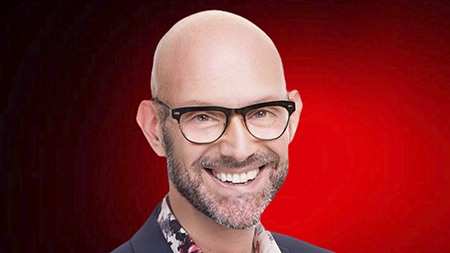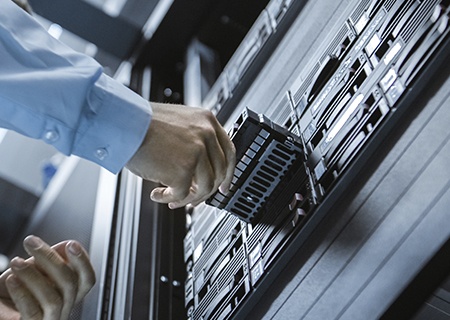Ask an Expert
Planning the right solution requires an understanding of your project and system requirements. Let Kingston's experts guide you.
Ask an Expert

Rob May is the founder and managing director of ramsac. He has a team of over 100 consultants working with him to deliver technology and cybersecurity services/support (and has done so for over 30 years).
Rob is the UK Ambassador for Cybersecurity for the Institute of Directors, and is ranked #5 in the Global rankings for Cyber Security Thought Leaders/Influencers. He is on the Advisory Board of The Cyber Resilience Centre for the South East, working with industry, academia and law enforcement. He is also an author, a thought leader, and an award-winning international speaker.
As MD of ramsac, a Managed Service Provider (MSP) for nearly thirty years, I have seen an awful lot of challenges. We have had recessions, technology shifts, and pandemics, along with a backdrop of economic and political pressures.

Lockdowns in their various formats and durations have undoubtedly caused hardship and damage to many businesses, but there are also businesses that are thriving in this current economy. I deal with a lot of businesses that are currently doing extremely well. The onset of the pandemic certainly changed working life for most people but, on the other hand, some have experienced positives.
Technology support companies typically charge per user per month and many will have seen decreasing annuities due to supporting clients with furloughed staff. There have also been changing business practices and business models where demand has most certainly offset the decrease in other areas.
Today’s model of work has become remote and it has driven the need to upscale cloud and data center provision. Many businesses are investing in technology, reconfiguring office space to reflect these new needs, and relocating server infrastructure. These needs and demands have spurred an increase in server upgrades (both on premise and in the cloud/data center). This is a sensible development, but I see many organizations getting it wrong.
A typical upgrade is going to comprise both memory and storage upgrades.
A memory upgrade is the easiest way to improve and optimize server performance. It is usually required when increasing virtual workloads, adding more users, implementing a new database program, or perhaps when adding commerce functionality to a website. Upgrading memory in your servers can support larger workloads, provide faster responses for those using the cloud, and improve speed for applications living in memory.
Increased server memory allows you to have more virtual machines and can increase allocation to maximize your existing hardware. Virtualization lowers total cost of ownership and allows more memory for Virtual Desktop Infrastructure (VDI), which means a faster response when apps sit in memory. (VDI is desktop virtualization where the desktop environments are hosted on a central server and delivered to end clients over a network.)

Storage is important for server virtualization in terms of capacity and, most significantly, in terms of speed. Random input/output and high data access demands can be severely limited by traditional mechanical hard drives in a virtualized host server. Servicing applications, users, and retrieving data have become limiting factors in overall system performance. Installing the right server memory along with non-mechanical solid-state drives (SSDs) provides the ideal accelerator for improving performance and capacity, which allows for virtualization and eventually being able to do more with less.
As server storage is increasingly offsite in data centers and is becoming more cloud-based, greater demands are placed on both the storage drives and the memory infrastructure. SSDs have fast-retrieving capabilities and enable cloud services to operate at optimum efficiency for each type of data being processed. A well-designed storage solution will deploy a tiered drive model (differing speed and price drives for different storage and access purposes) which ensures an organisation has the right data on the right tier to maximize performance while remaining economical.
It starts at the component level and many people do not properly consider memory (which is a big part of the server price). Server DIMM memory modules are either going to be unbuffered uDIMMs, registered RDIMMs, or load-reduced LRDIMMs. All three types are compatible physically, but you must specify the correct DIMMs as they CANNOT be mixed.
It’s also vital to match the correct memory to the exact processor you have in each server. The number of memory channels and memory modules can have a significant impact on performance. People need to keep this in mind when considering a staged upgrade. Do not buy 12 months of memory today for an upgrade that goes beyond your requirements or even limits your performance. Plan and make sure you get expert advice on the configuration for each individual server.
Memory standards and specifications are stipulated by an organization called JEDEC that is globally responsible for the development of open standards for the microelectronics industry. Paying attention to its standards and specifications can help with informed decision making. For example, current considerations on motherboards really need to look at the new standard for DDR5, which dramatically increases memory density and speed. DDR5 DIMMs will have the same number of pins (288) as DDR4 DIMMs, but the pin layout is different and can only be used in a dedicated DDR5 slot.

Upgrades are a shrewd decision in our ever-changing, ever-evolving business landscape. Planning, specifying, and buying for the right upgrades, however, is an art! Get it wrong and you will fail to get optimum performance and waste time and money. Do not rely solely on the advice of your server manufacturer either as, in my experience, they will rarely take the time to work through your plans and/or look correctly at all the configuration/performance issues but rather try to sell you more memory. Personally, I would use the “Ask an Expert” team at Kingston, who will be able to advise you on nearly all server platforms. Their advice is rarely ever wrong!
Do not simply replace servers. Get good advice and look at an intelligent upgrade roadmap that covers your current needs and your projected growth.
#KingstonIsWithYou

Planning the right solution requires an understanding of your project and system requirements. Let Kingston's experts guide you.
Ask an Expert